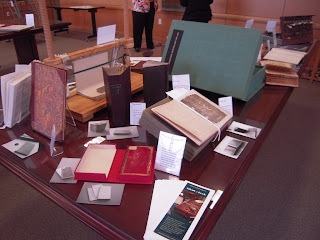She gave me some helpful tips about working in a preservation department, working with other departments, and being a supervisor. No matter what level you are dealing with, giving people concrete evidence of damage leads to better dealing with the individuals of the department. For instance, you have a maintenance worker who wants to cut a corner to save time, if you show them an item damaged by the cut corner in the past, it makes it easier for them to understand the importance of the protocol the library has in place.
Along with that, as the head of preservation Sharlane must have a good relationship with everyone inside the library and at the branches in order to run the department smoothly. This means you will have to deal with a lot of different personalities and need to make an effort to understand their views. Sometimes you will need to simply recommend other methods or compromise with the person. Sharlane also reminded me that there will be library policies that I won't like or find that they put more items at risk, but I have to remember that there is no perfect library. In the future, you choose the battles carefully.
This week we explored one of Sharlane's other responsibilities, which is hanging and creating exhibits. We went up the the second floor with a cart of items used to make displays, such as signs and holders. I helped Sharlane hang the most expensive item in the library, which was a rolled up scroll. While still rolled up, Sharlane hung the item on the nail, then I helped her slowly unroll the object. The scroll is paper mounted on fabric. The paper has become fragile. In order to get the item to hang straight, we had to be innovative and made a strip of paper that could push between the wall panels-holding the scroll in place.
Some of the items Sharlane has dealt with in the past are color prints. She told me each item had a sheet of non-acidic buffer paper, separating the item from the matting. She did this because she was unsure as to what sort of materials the matting board was made of, and it's better to take precautions in this case.
Sharlane also cut a piece of clear plastic to protect some special exposed items for one of the displays. Here she is shown brushing off the surface of the plastic before securing it to the box:
After our conversation today about being a liaison to other departments and learning how to handle other personalities, I witnessed Sharlane using one of the techniques she recommended to me. She made a suggestion for some of the care of the materials, to which she was answered curtly 'we aren't going to do that'.
I helped people move the tables and cases, as well as clean each. After that, Sharlane and I set up a section of one of the tables for preservation's display. It featured several repairs, the sewing frame, my quarto, and some bookmaking supplies. When we were close to finished the dean came in and reviewed the room and the displays that had already been put up. Here is the preservation display:
Here are some of the other department's displays:
When we finished creating our display, we went back to bookmaking. I glued the spine of the octavo and brought it up to the same place as the other books we are making (adding on boards and cutting the leather to fit the item).
Once I had the two pieces of leather cut I learned that the outer edges needed pared so they would not bubble out the end sheets. There are four different methods you can use when paring leather: go across the leather with a paring knife, scalpel or skiver, or pull towards you with the large paring knife. The large knife must be sharpened with honing oil on a sharpening stone. It is best to sharpen it by making figure 8s across the surface of the stone with the blade.
What method you use depends on how your leather reacts (not to mention your aptitude in using it), so it is important to use a test piece before proceeding. Be sure do the paring over a marble surface and have a dry paper towel handy to wipe away the shavings as you work. Here is the piece I tested with each knife by the edge I used it on:
To the right is the large paring knife, below is the scalpel, and above is the small paring knife.
This is the skiver.
I decided that the small paring knife was easiest to use and least damaging to my leather choices. Here are some photos of the pared leather:
When you get good enough at using paring knifes you can take off whole chunks at once. Sharlane demonstrated how normal leather reacts:
I left the library at 6:00pm, after working on a few other materials that I could take home.
*If any processes are repeated in my blog, it is because they were repeated during my practicum experience. I apologize for any redundancy.



























No comments:
Post a Comment